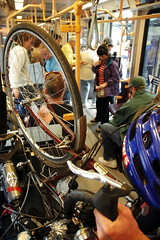TriMet has just released the results of their Bikes on MAX survey that they launched in August of last year.
In the Executive Summary of the survey, TriMet points to the trends of growth in both MAX and bike ridership in Portland. They say those trends have, “resulted in an increasing number of bike-on-light rail trips” (I previously covered that issue in my story, TriMet grapples with bike capacity issues, from May 29th).
“To increase the number people accessing MAX light rail at the time of their choice, facilities or programs that would allow cycling at each end without needing to bring a standard size bike onboard are necessary.”
–from the Executive Summary
TriMet says this study was undertaken, “to gather data on when, where and why customers with bikes rode MAX light rail.” According to the documents released today, this data will now be used to develop a Bike Facilities Plan that will, “recommend specific ways to encourage and integrate bikes with transit while minimizing conflicts.”
In the “Recommendations” section of the survey’s Executive Summary, TriMet refers to allowing bikes on-board at all hours as a “lifeboat for cyclists — reassurance that they have a backup option in case of fatigue or mechanical issue.”
However, they list several factors (the main one being a lack of space) that prevent them from expanding existing space for bikes on trains. They also say that the design of the MAX light rail system limits the length and number of trains in service.
- The TriMet Bikes on MAX Survey:
- Executive Summary (35KB PDF)
- Complete Survey (1.12MB PDF)
- Bikes-on-MAX FAQs (15KB PDF)
TriMet’s analysis around this survey further validates that their focus is not on expanding bike access on the trains. Instead, they want to design their system so that people won’t need to bring a bike on board at all.
While they re-iterate that a blanket, rush-hour ban on bikes is not in the cards, they make it clear that “new alternatives need to be explored,” and that folding bikes “are a great option for both bus and MAX passengers.”
Aware that folding bikes will never make up a large percentage of bike riding passengers, the future for TriMet and bikes will be improved bike facilities at transit stops. They say this approach will, “encourage many more people to combine bikes and transit than could be accommodated onboard transit alone.”
TriMet seems to be looking to the future with hopes to emulate other countries with “mature bike and transit systems.” They specifically cite the Netherlands, where bikes are used as transport to the station for 33% of all rail transit trips (and only one in ten people bike from the station to their final destination).
TriMet may have a vision of a bike park-and-ride system, but will improved facilities alone be enough to encourage Portlanders to leave their bikes at the station?
According to their web survey (1173 responses, of which 568 came from BikePortland readers), 94% of riders take their bike on board and only 18% of current bike-MAX riders indicated that they would park their bike at their boarding station (if secure parking was available). In the on-board survey (425 responses) 76% said they needed their bike to reach their destination and would not be willing to use secure bike parking even if it existed. Further complicating the issue is that 38% of respondents said they would drive if they could not bring their bike on board.
Here are a few more interesting numbers from the survey:
- 2,100 passengers rode MAX light rail with a bike on weekdays during August 2007, accounting for 3.8% of all passengers.
- On the Yellow Line (Interstate), 14% of passengers from 4-6pm had a bike.
- One-quarter of all light rail vehicles intercepted at peak hours carried three bikes or more.
At the end of the Executive Summary are a list of “Planning Recommendations” and “Immediate Actions”. The recommendations are to:
- Develop and implement a Bike Facilities Plan that includes extensive short-term and long-term bike parking at stations, including facilities for customers that need a bike at each end of their trip.
- Consider bike transport impacts in future MAX light rail service improvements and develop tools for predicting or modeling future multimodal demand.
- Explore options to provide additional bike-on-bus capacity and bike-to-bus facilities
And the actions are to:
- Increase usage of existing bike lockers through more efficient management of the program and by relocating lockers to stations where usage is highest.
- Improve bike transport onboard MAX by making improvements to designated bike spaces, adding signage to specify that passengers allow cyclists to store their bikes in designated spaces, and make bike transport options in seating areas more flexible.
- Clarify customer information so that customers can better evaluate existing options including: how to transport bikes onboard, what kinds of conditions to expect, and bike parking. Partner with manufacturers and retailers to promote folding bikes.
- Make investments in bike parking where possible, given limited resources.
Colin Maher, TriMet’s bike programs intern will present the survey results to the Portland Bicycle Advisory Committee tonight.
— For more coverage of TriMet, browse the TriMet Archives.



